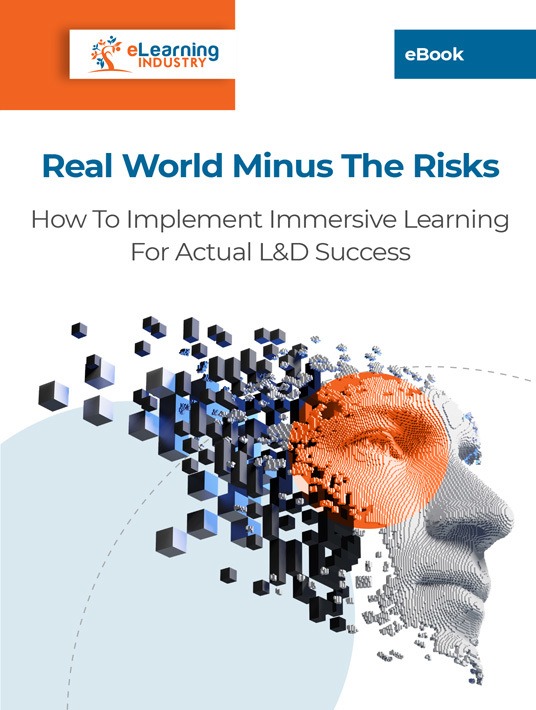Enhance Employee Training With Immersive Learning
Most employees avoid training at all costs because it’s generic, boring, and time-consuming. They’d rather be doing something more productive, like hitting their sales targets or tackling that pile of paperwork. But immersive learning gives you the power to pique their interest and develop activities that resonate with them. They have the opportunity to cultivate crucial skills, identify limiting performance behaviors, and expand their experiential knowledge. All without taking real-world risks that might lead to lower sales, lower customer service scores, and workplace accidents. They get as many "do-overs" as they like to fine-tune their approach. Here’s how to use immersive learning to foster an emotional connection and build meaning.

1. Simulations Framed With Personal Anecdotes
The most profound immersive learning experiences are based on real-world challenges that are relatable. Invite employees to share their personal stories from the workplace, then use them as inspiration for your next VR training simulation. They’re able to quickly immerse themselves in the situation because they’ve been there before. Or at least they know someone who has and they can assign meaning to the online training experience. It’s not simply a handbook that outlines all the things that can go wrong and how to mitigate risks. It’s an interactive online training resource that puts them in the middle of the action and builds self-confidence.
2. Interactive Problem-Solving Scenarios
Every job position and department has unique obstacles they must face in the workplace. Develop VR or AR training problem-solving scenarios that encourage them to use all the available online training resources and skills to reach the best outcomes. For example, a virtual customer appears on their screen and sums up their pain points. Then employees must choose from a list of products based on the information and past experiences. You can also use this approach for co-worker conflicts, COI breaches, and customer service issues, such as how to handle complicated returns or resolve complaints.
3. Customer Service Walkthroughs
Speaking of customer service, another meaningful immersive learning activity to upload to the LMS is step-by-step walkthroughs. Show them how to complete tasks and build interpersonal skills that tie into their job roles. Include supplemental links so that they can explore related processes or expand their product knowledge. These walkthroughs can also be followed by VR training simulations that allow them to apply what they learned. The catch is that every online training activity should be self-contained. For instance, one walkthrough covers the return process so that employee training participants can explore all the steps and protocols while another addresses product exchanges or offers service packages.
4. Product Pitch Online Training Tutorials
Your sales staff may know the ins and outs of your new product line. They may have memorized the catalog by heart and know all the features and specs. But do they know how to pitch it to customers, how to qualify leads or how to actively listen to identify consumers’ needs? Immersive learning product tutorials give them the opportunity to watch a pro in action in order to mimic those behaviors on the job and improve customer satisfaction. They can also personalize the pitch once they have an eLearning template to work from. Be sure to include some common sales mistakes to avoid, such as being too forceful with the customer or forgetting about add-ons and upgrades.
5. Recorded Performance Recaps
This Mixed Reality learning technique is a bit unconventional, but it can shed light on personal pain points. Record the employee as they perform a work task and let them play it back in the VR environment. Or allow them to watch in on their mobile device and add AR training links at the end based on their performance gaps. Another option is to record a series of tasks using the same "actor" for everyone to view. Then ask them to evaluate the process and identify areas for improvement. Did the demonstrator miss any steps? Did they use the appropriate skills? Whatever method you choose, performance recaps prompt personal reflection. Employees are able to watch the task from an outsider’s perspective and objectively assess behaviors and habits.
6. Exploration Demo Videos
Produce Mixed Reality learning demo videos that offer a deep dive into products, processes, and policies. For example, the VR training video features the inner workings of your latest product. How does it function? What are the most common issues? Employee training participants simply click on the individual components to learn more about them and the purpose they serve. Exploration demo videos offer two notable benefits. Firstly, employees are better equipped to pitch the products or perform the tasks because they understand the dynamics. Secondly, they can help customers troubleshoot known issues because they’ve seen all the technical elements up close.
7. Skill Serious Games
Serious games blur the line between entertainment and meaningful online training. In this case, they help build core competencies and skills employees need on the job as well as identify personal areas for improvement. You can use VR or AR training tech to achieve the online training objectives based on your preferences, budget, and desired outcomes. For example, busy customer service staffers may not have the opportunity to slide on a headset. But an immersive learning AR game is just right for JIT support.
Meaningful online training experiences are personal, relevant, and emotionally engaging, regardless of the employees' position, department, or background. They give employees the opportunity to contextualize the online training content and see how it translates on the job. This article can help you incorporate memorable Mixed Reality training tools into your online training strategy without going over budget. Why not catch staffers off guard—for all the right reasons—by immersing them in real-world challenges and building their self-confidence?
A Mixed Reality training strategy doesn’t have to drain your organization’s resources or make you go over budget. Download the eBook Real World Minus The Risks: How To Implement Immersive Learning For Actual L&D Success, and discover how you can benefit from incorporating immersive learning into your online training program. Provide an engaging training experience and boost your employees’ confidence with a Mixed Reality training solution.

